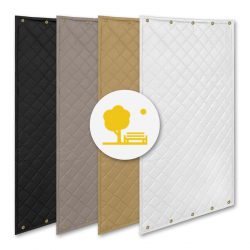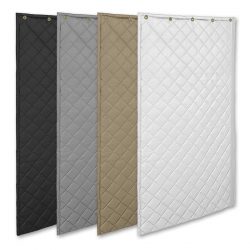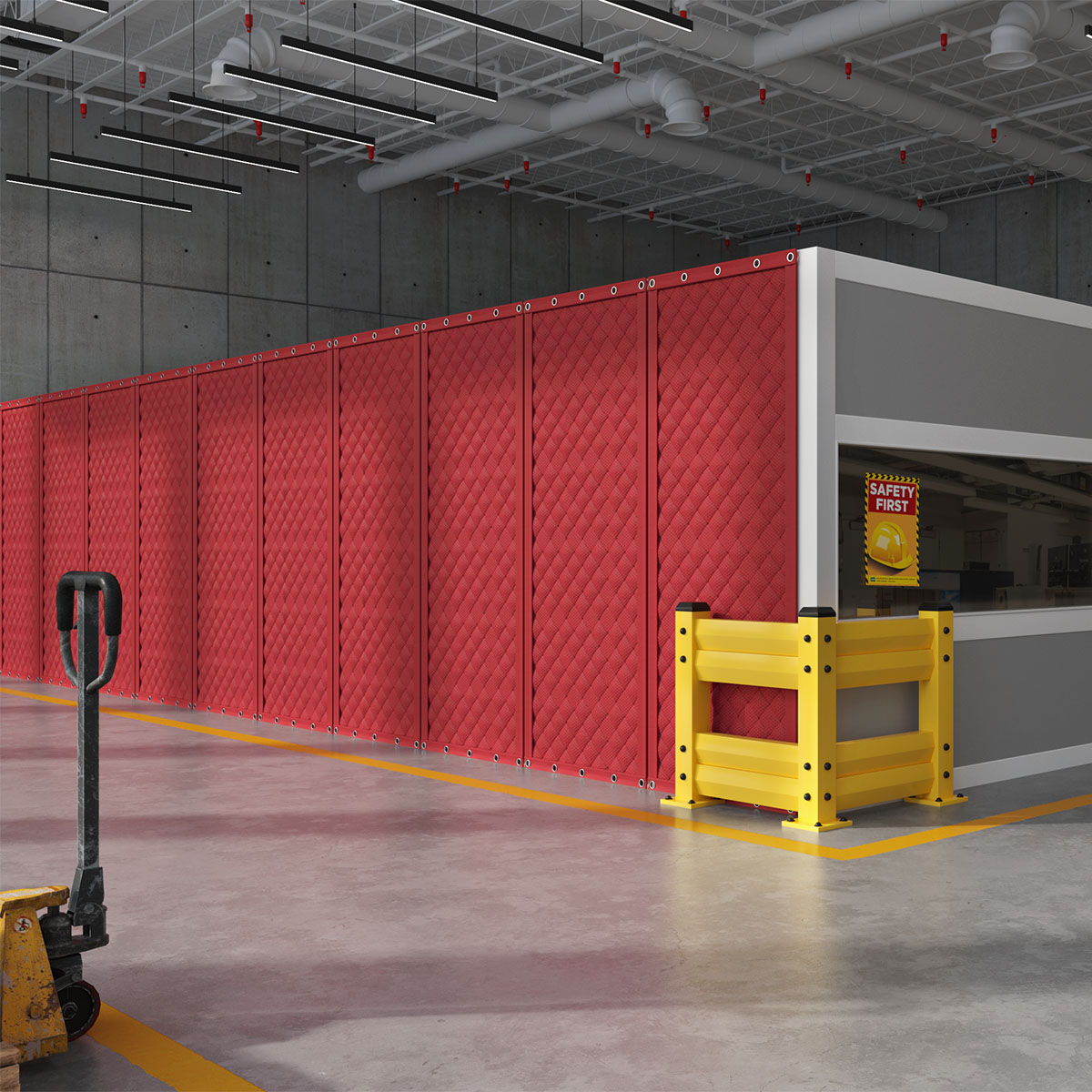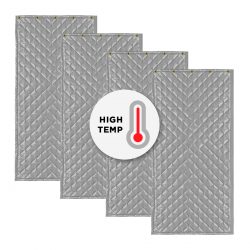Sound Blankets
Acoustic sound blankets are manufactured in two typical configurations. We have sound blankets that absorb sound to reduce noise as well as absorber-barrier combination blankets that both absorb and block sound. These acoustic blankets utilize a fiberglass absorber quilted to various facings with an optional barrier septum for use in indoor, outdoor or high-temperature applications.
Most often, these quilted fiberglass blankets are used to control sound and noise in industrial, manufacturing, and construction, but they also have various uses in private, residential, and commercial applications.
Please Note: While properly installed sound blankets will noticeably reduce noise, they will not eliminate it entirely. All blankets can be tailored to your project, but specific project needs will determine the proper blanket type and quantity. If you are unsure of either, please call one of our acoustical specialists at 800-782-5742.
Showing all 15 results
-
PrivacyShield® AQFA-1 Acoustic Wall Blanket
Original price was: $159.99.$149.99Current price is: $149.99.
Sale! -
PrivacyShield® AQFA-10 Soundproofing Blanket
$249.99
-
PrivacyShield® AQFA-10EXT Exterior Soundproofing Blanket
$282.99
-
PrivacyShield® AQFA-10DES Designer Colors Soundproofing Blanket
$426.99
-
PrivacyShield® AQFA-11 Industrial Soundproofing Blanket
$374.99
-
PrivacyShield® Industrial Sound Enclosure
Learn More
Frequently Asked Questions
A sound blanket is a ceiling or wall covering that is often used in industrial settings or on construction sites for noise control. You may also hear sound blankets referred to by other names, including soundproofing blankets, noise blankets, industrial sound curtains, or acoustic wall blankets. Sound blankets are extremely versatile. While they are typically used as partition walls or enclosures in manufacturing spaces with machinery, they can also be used in homes or other settings to block sound through doors and windows. Not all sound blankets are used for blocking sound and preventing noise from transferring outside of a space. Some primarily absorb sound to reduce noise and echo. The amount of noise they absorb or block depends on the blanket’s material, its thickness, the stitching, and the volume and type of noise.
Sound blankets are made for two distinct purposes: absorption and soundproofing.
Sound absorption blankets are constructed using two layers of acoustical fiberglass batting and feature a durable vinyl-coated fiberglass cloth facing. Our AlphaSorb® Dual-Sided Outdoor Absorptive Sound Blanket adds sound absorption to exterior applications while our AlphaSorb® Dual-Sided Absorptive Sound Blanket is used to add sound absorption to interior applications.
Soundproofing blankets consist of many different layers. The middle layer is a non-reinforced loaded vinyl barrier with a 1-or 2-lb per square foot mass, centered between two layers of recycled fiberglass. The layers are faced with a vinyl-coated quilted cloth, to create the finished product. One example of this style is our PrivacyShield® Dual-Sided Absorptive Soundproofing Blanket. Other products, like our PrivacyShield® Absorptive Soundproofing Blanket, also have a reinforced barrier backer and quilted absorber face.
True soundproofing blankets are made by adhering a mass loaded vinyl sound barrier to fiberglass batting which is faced with vinyl-coated fiberglass cloth. When installed, soundwaves are absorbed by the fiberglass layer to reduce noise and echo within the room. The thickness of the fiberglass determines how much of the sound is absorbed by the blanket. The sound barrier layer acts to block soundwaves from transmitting to adjacent spaces. In order to provide effective soundproofing, the blanket needs to cover the entire wall or walls. Soundproofing blankets can be used on job sites, in manufacturing settings, and also in residential settings as a way to soundproof a room. Soundproofing blankets significantly minimize the amount of noise caused by large equipment like HVAC systems and dust collectors. They also allow work sites to meet OSHA’s noise level requirements and allow workers to stay on-site longer.
No, sound blankets and moving blankets are not the same. Moving blankets are thick, padded blankets designed for protecting furniture while moving. Their use for noise reduction is just an auxiliary benefit. Echos are magnified by hard surfaces, so most softer textile material has some benefit for reducing noise including moving blankets or even everyday curtains. You can use moving blankets for sound absorption in a pinch, however, moving blankets have an entirely different design than soundproofing blankets. The design of moving blankets allows them to muffle sounds to some degree, but they lack the various layers and inner core that true sound blankets have. This means that their ability to absorb noise is minimal by comparison. A sound blanket is designed with various intentional layers, including a foam or fiberglass core, which helps absorb certain amounts of sound to prevent it from passing through the blanket.
Sound blankets and acoustic panels can both be used to reduce noise and reverberation in a room. The best option for you will depend on your needs and the space that you are working with. Blankets offer versatility, and are ideal for industrial, commercial, and construction sites. There are many types of sound blankets for a range of needs, including soundproofing, dual-sided, exterior, and high temperature. They can create permanent or temporary sound barriers that block out workers’ noises or the noise of equipment like HVAC systems, so they do not bother anyone. Sound blankets have an industrial style and typically come in black, white, gray and tan. Panels, on the other hand, can be made with hundreds of fabric options to compliment interior spaces in offices, studios, and other areas where you want to control noise levels.
Air conditioning units are notoriously noisy and can be a major source of aggravation. While there are other methods of dealing with a noisy unit, one solution is to install a sound blanket around it to significantly minimize the noise. Sound blankets aren’t bad for the unit and do not restrict airflow. They can help insulate the unit’s compressor, to ensure a more consistent temperature and prolong the compressor’s lifespan.
Sound blankets will only soundproof a room if there is a vinyl sound barrier included. Moving blankets or sound blankets that are not constructed with a sound barrier will not be able to soundproof a room. In order for blankets to work effectively as sound blockers they have to cover the entire wall. If there are gaps, then sound will pass through it.
You can hang sound blankets from virtually any surface in a room; the ceiling, the walls, windows, doors–you can even set them on the floor. The key to making sure that sound blankets work effectively is to install them the right way. For all vertical surfaces, you want to choose blankets that have grommets, which make them easy to hang. Our PrivacyShield® Absorptive Soundproofing Blanket is one example. This product has grommets on the top edge and Velcro along the sides, which allow you to secure it to frames so that it stays firmly in place. Our PrivacyShield® Absorptive Soundproofing Blanket Partition is another option for doorways and walls. This blanket is a freestanding option that you can easily move to different locations as needed.
To cover machinery, you can use our PrivacyShield® Industrial Sound Enclosures, which are suspended in a durable steel tube frame. These enclosures can be customized to meet your needs and use high-quality materials for interior or exterior use.












